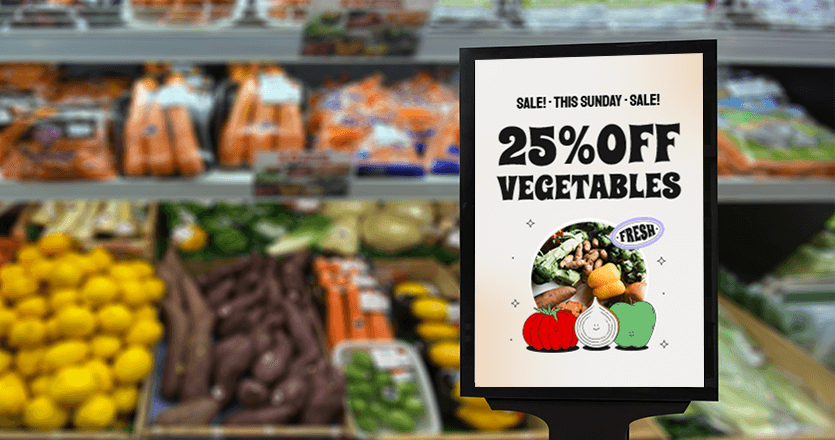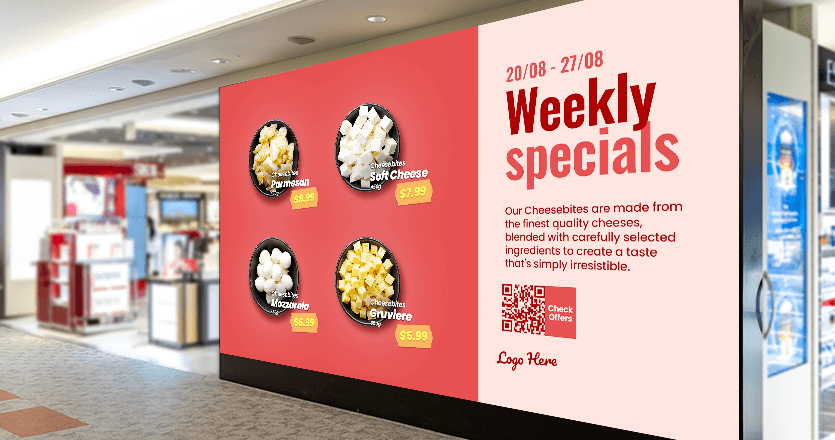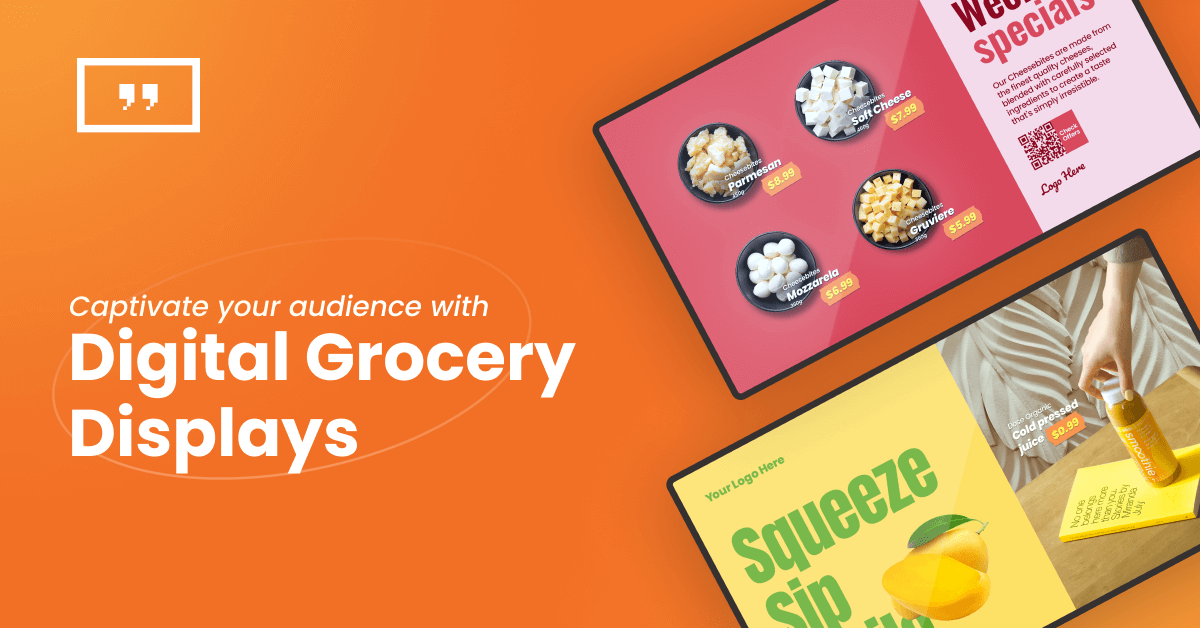A grocery store environment today doesn’t quite look like it used to. The pursuit of higher engagement, operational efficiency, and new trends in food marketing have introduced technologies such as digital signage and have transformed how businesses showcase their products, offers, and promotions.
A digital grocery display provides a newfound dynamism and customization to traditional grocery store displays. Below we will dive into how digital signs can boost creativity and sales, while also focusing on costs.
Benefits of digital signage in grocery shops
Enhanced visual appeal
Digital signs bring a modern look to grocery store displays. Dynamic and brightly lit graphics and videos make for more captivating content than old-fashioned posters. Screens can thus increase the capture of customers’ attention, whether we are talking about promotional displays, new products, or seasonals offers.

Real-time updates
Traditional fixed display shelvings are hard to update. Pricing tags, aisle signs, and promotional stands that are paper and plastic based quickly become obsolete as the rapid realities of modern inventory and pricing management are constantly in flux.
This type of static grocery display signage then seems to be rather old compared to the alternative of digital signage. With a content management system that can be centrally and remotely controlled, digital grocery displays allow managers to adjust content based on stock levels, time of day, or current sales data.
These capabilities ensure that marketing messaging is thus relevant and timely, impacting on both user experience and operational efficiency.
Interactive experience
Digital signs have also introduced considerable interactive affordances. Touchscreens, QR codes, social media walls can all create an additional level of interactivity to your messaging that can set your store apart from the competition.
Some ideas that can enhance the shopping experience include, useful nutritional information in on-screen pop-ups, QR codes that can trigger unique offers, or even loyalty programs forms that customers can fill out themselves without leaving the screen.
Targeted advertising
By leveraging an intelligent digital signage platform that can customize content instantly and remotely, advertisers and marketers can also display targeted advertising, such as recommended products, a type of content that is already familiar to digital native shoppers.
Personal shopping habits, demographic data points, specific dayparts, and inventory insights can trigger different content playlists and schedules and offer a messaging that is both more personalized and better suited to sales objectives.
Operational efficiency
Content management within a digital signage system deployed in a retail environment, such as a grocery store, makes it so much simpler for retailers to update their display content. The need for manual labor in setting up and updating bulk displays, pricing tags and promotional stands greatly drops with the adoption of digital grocery signs.
Moreover, integrating your grocery digital signs with warehouse and inventory management systems means that you will no longer blindly display products and offers. Instead retail managers can cycle through the most appropriate content in accordance with current inventory levels and swifting needs. Time and workforce requirements are thus greatly optimized.
Cost of digital signage
Implementing a digital signage system into your grocery, delicatessen, bakery or other similar store will include:
- Hardware: Encompasses screens, media players, fixtures and peripherals. This is the sum of the material investment, and if you opt for commercial-grade screens, it could set you back anywhere from $500 to $2,000 each.
- Software: Content management systems, or digital signage software as it is also known, are necessary to design, schedule, and manage content for your grocery displays. These software licenses come in various types and price points but the main thing to keep is that you can opt for one-time licensing or any subscription model. With Yodeck you can start for free if you only run one screen, while scaling up from that remains accessible with our base plan costing just $8/screen per month.
- Installation and Maintenance: Now that you have everything you need, you need to consider installation and maintenance costs. A professional setup may be necessary if you are deploying a high end system to ensure both safety and quality. On the other hand you will have to make sure that your hardware is well taken care of, while a subscription based license will eliminate the need of extra costs for software updates.
Advantages of digital signage over traditional grocery store displays
Adaptability
With digital content management systems, updating, editing and automatization of content and messaging is much easier and efficient than with paper-based materials. Grocery display fixtures can be upgraded with digital screens that adjust to any type of varying factor, such as weather, holidays, limited-time offers and much more.

Cost-effectiveness over time
Digital signage deployment is indeed more expensive initially. Nonetheless, the affordances it creates for store managers will render the investment more economical in the long term. These savings will aggregate over time through reduced expenses on materials and labor necessary for keeping content relevant and regularly updated.
Increased sales
Research indicates that digital displays can boost supermarket sales significantly. Through increased attention capture, engagement and the encouragement of impulse buying, a led screen breathes new life into the general store ambiance by highlighting and recommending products in an attractive, persuasive, and even personalized manner.
Reduced waste
Consumers are more environmentally conscious than ever. It is thus only logical for businesses to pursue any measures that can lead to reduced waste such as opting for digital over traditional signage. The less paper and plastic a store has to use, the higher the chances that consumers will build a more loyal relationship with the business.
Conclusion
The adoption of in-store digital installations is becoming ever more prevalent. Businesses stand to gain a lot from this transformation, provided they seriously consider and deploy digital signage early enough. Grocery stores that aim to modernize their customer experience and enhance sales should plan for the digital realities of their customer base today, and realize this strategic investment and transition with a trusted partner.
Take the next step to digitize your store
When you’re ready to start your digital transition, here are three ways that Yodeck can help:
- Book a demo: Our team will show you how easy it is to use Yodeck and answer all your questions.
- If you want to delve deeper into digital signage, visit our Blog and Yodeck Academy. Both are full of use cases, guides and more resources to make you an expert on Yodeck.
- Register to try Yodeck yourself today. Your first screen is forever free!
